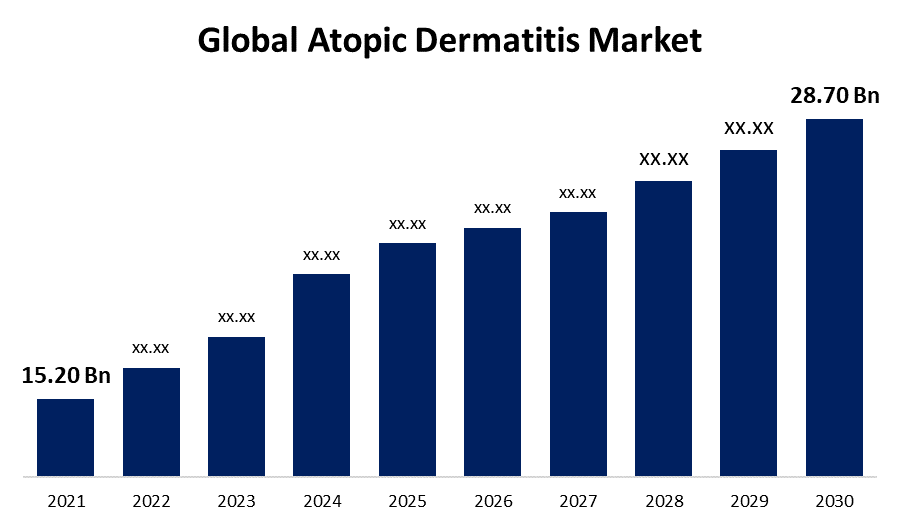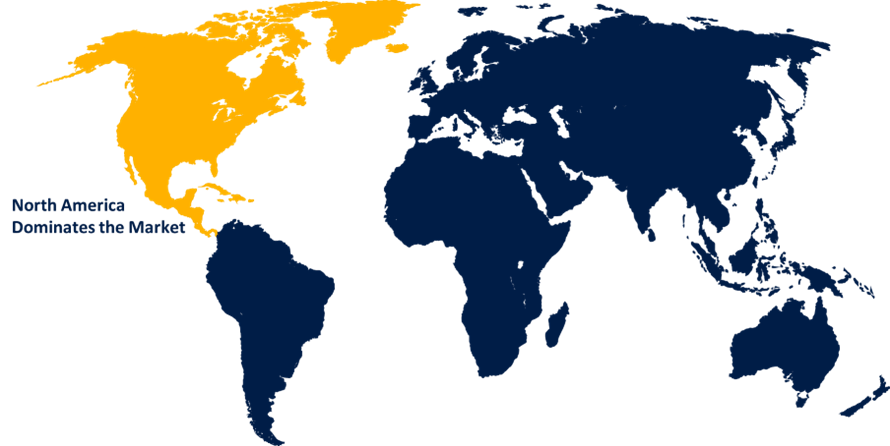Global Atopic Dermatitis Market Size, Share, and COVID-19 Impact Analysis, By Drug Class (Biologics, PDE4 Inhibitors), By Route Of Administration (Topical, Injectable, Oral), By Region (North America, Europe, Asia-Pacific, Latin America, Middle East, and Africa), Analysis and Forecast 2021 – 2030) Global Atopic Dermatitis Market Insights Forecasts to 2030
Industry: HealthcareGlobal Atopic Dermatitis Market Insights Forecasts to 2030
- The Global Atopic Dermatitis Market Size was valued at USD 15.20 Billion in 2021.
- The Worldwide Atopic Dermatitis Market is Growing at a CAGR of 10.5% from 2022 to 2030
- The Global Atopic Dermatitis Market Size is expected to reach USD 28.70 Billion by 2030
- Asia Pacific is expected to Grow the fastest during the forecast period

Get more details on this report -
The Global Atopic Dermatitis Market Size is expected to reach USD 28.70 Billion by 2030, at a CAGR of 10.5% during the forecast period 2022 to 2030.
Market Overview
Red, itchy, puffy, and cracked skin are symptoms of the chronic illness known as atopic dermatitis. Treatment is necessary because the affected area can release white fluid. Atopic dermis typically starts with childhood and can worsen as people age. Genetic abnormality, environmental exposure, immune system dysfunction, and skin permeability issues are among the causes of atopic dermatitis. Atopic dermatitis is a condition that causes skin to become dry, red, itchy and rough. It is one kind of dermatitis. The function of the skin barrier is harmed. The skin becomes more sensitive, prone to infection, and dry due to this lack of barrier function. The body is not harmed by atopic dermatitis. That doesn’t mean that the skin is unclean or sick, and its not communicable. The symptoms can be managed with the aid of therapies. Derm, which means "skin," and itis, which means "inflammation," make up the word "dermatitis." The phrase as a whole refers to "skin irritation." The Greek word "ekzein," which means to "boil over" or "burst out," is where the term "atopic dermatitis" comes from.
Report Coverage
This research report categorizes the market for Atopic Dermatitis market based on various segments and regions and forecasts revenue growth and analyzes trends in each submarket. The report analyses the key growth drivers, opportunities, and challenges influencing the Atopic Dermatitis market. Recent market developments and competitive strategies such as expansion, product launch and development, partnership, merger, and acquisition have been included to draw the competitive landscape in the market. The report strategically identifies and profiles the key market players and analyses their core competencies in each sub-segments of the Atopic Dermatitis market.
Global Atopic Dermatitis Market Report Coverage
| Report Coverage | Details |
|---|---|
| Base Year: | 2021 |
| Market Size in 2021: | USD 15.20 Billion |
| Forecast Period: | 2021-2030 |
| Forecast Period CAGR 2021-2030 : | 10.5% |
| 2030 Value Projection: | USD 28.70 Billion |
| Historical Data for: | 2017-2020 |
| No. of Pages: | 200 |
| Tables, Charts & Figures: | 100 |
| Companies covered:: | AbbVie Inc., Arcutis Biotherapeutics, Inc., Asana Biosciences, Inc., Astellas Pharma, Inc., Bayer AG, Inc., Bristol-Myers Squibb Inc.,Dermavant Sciences, Inc.,Eli Lilly and Company, Inc., Galderma, Inc., Incyte Corporation, Inc., Leo Pharma, Inc., Novartis AG, Otsuka Pharmaceuticals Co., Ltd., Pfizer Inc., Regeneron Pharmaceuticals, Inc., Sanofi SA, Inc. , Viatris, Inc |
| Pitfalls & Challenges: | COVID-19 Empact, Challenge, Future, Growth, & Analysis |
Get more details on this report -
Driving Factors
Throughout the course of the projection period, it is expected that the market will be driven by factors such as the rising prevalence of atopic dermatitis, a robust pipeline, the emergence of biologics, and untapped potential. Atopic dermatitis is becoming more and more prevalent. As a result of the quick development of novel pipeline medications, the atopic dermatitis market is anticipated to increase significantly during the forecast period. The expansion of the atopic dermatitis sector, as well as the rise in the need for new biologics and product approvals, are both expected to contribute to the market's expansion. Additionally, it is anticipated that the market will expand at a faster rate due to favourable reimbursement policies in developing nations and the high prevalence of atopic dermatitis. Moreover, the growth in awareness regarding the availability of treatments for the disease and different initiatives performed by governments to provide better and more economical treatment are also predicted to influence the atopic dermatitis market share internationally.
Restraining Factors
In contrast, allergic reactions to off-label treatments and the expiration of product patents can hinder the growth of the target market during the atopic dermatitis market forecast period. The easy availability of expensive treatment and poor reimbursement policies in developing regions across the globe are expected to act as major restraints towards the growth of the Atopic Dermatitis market.
Segmentation
- In 2021, the Injectable segment is dominating the market with the largest market share over the forecast period.
On the basis of route of administration, the global atopic dermatitis market is segmented into Topical, Injectable, Oral. Among these, the injectable segment is dominating the market with the largest market share over the forecast period. Tofacitinib and ruxolitinib are two more injectable biologics that are currently being studied in clinical trials. In the near future, biologics are anticipated to alter the therapy landscape for AD. They are being studied for the treatment of paediatric patients to satisfy the huge unmet need of this market. There are extremely limited therapy choices for paediatric children with AD. Dupilumab development programme is one of the clinical initiatives aiming at developing AD medications for juvenile patients. The programme aims to enhance clinical research.
- In 2021, the biologics segment holds the largest market share over the forecast period.
On the basis of drug class, the global atopic dermatitis market is segmented into Biologics, PDE4 Inhibitors. Among these, the biologics segment holds the largest market share over the forecast period. Biologics have a huge clinical benefit over conventional topical treatments as they target the inflammatory mechanisms fueling the disease rather than just addressing the symptoms. These medications have a competitive advantage due to their great specificity. In severe circumstances, such as second- or third-line treatment for patients who have not responded to previous systemic medications, biologics are typically administered. Due to their excellent efficacy, product approvals are increasing, and a strong pipeline of biologic medications for atopic dermatitis is available, all of which contribute to the biologics segment's growth.
Regional Segment Analysis of the Atopic Dermatitis Market
- North America (U.S., Canada, Mexico)
- Europe (Germany, France, U.K., Italy, Spain, Rest of Europe)
- Asia-Pacific (China, Japan, India, Rest of APAC)
- South America (Brazil and the Rest of South America)
- The Middle East and Africa (UAE, South Africa, Rest of MEA)
North America is dominating the market with the largest market share over the forecast period.

Get more details on this report -
The atopic dermatitis market was dominated by North America by geography in 2021 and is anticipated to continue to do so for the duration of the forecast period. This is primarily attributed to the rise in atopic dermatitis prevalence, increased patient treatment awareness, and development in the atopic dermatitis sector. Moreover, a strong healthcare system and early acceptance of innovative drugs. However, Asia-Pacific saw the greatest growth rate for the atopic dermatitis market, and it is anticipated that this trend will continue during the projection period. This is due to the region's large patient population, fast evolving healthcare technologies, and rising healthcare spending.
Recent Developments
- In April 2021, the review of RINVOQ for patients with atopic dermatitis who are adults and adolescents has been extended by AbbVie under the sNDA. The PDUFA was extended till the third quarter of 2021.
Competitive Analysis:
The report offers the appropriate analysis of the key organizations/companies involved within the global Atopic Dermatitis market along with a comparative evaluation primarily based on their product offering, business overviews, geographic presence, enterprise strategies, segment market share, and SWOT analysis. The report also provides an elaborative analysis focusing on the current news and developments of the companies, which includes product development, innovations, joint ventures, partnerships, mergers & acquisitions, strategic alliances, and others. This allows for the evaluation of the overall competition within the market.
List of Key Companies
- AbbVie Inc.
- Arcutis Biotherapeutics, Inc.
- Asana Biosciences, Inc.
- Astellas Pharma, Inc.
- Bayer AG, Inc.
- Bristol-Myers Squibb Inc.
- Dermavant Sciences, Inc.
- Eli Lilly and Company, Inc.
- Galderma, Inc.
- Incyte Corporation, Inc.
- Leo Pharma, Inc.
- Novartis AG
- Otsuka Pharmaceuticals Co., Ltd.
- Pfizer Inc.
- Regeneron Pharmaceuticals, Inc.
- Sanofi SA, Inc.
- Viatris, Inc.
Key Target Audience
- Market Players
- Investors
- End-users
- Government Authorities
- Consulting And Research Firm
- Venture capitalists
- Value-Added Resellers (VARs)
Market Segment
This study forecasts revenue at global, regional, and country levels from 2019 to 2030. Spherical Insights has segmented the global Atopic Dermatitis market based on the below-mentioned segments:
Atopic Dermatitis Market, By Route of Administration
- Topical
- Injectable
- Oral
Atopic Dermatitis Market, By Drug Class
- Biologics
- PDE4 Inhibitors
Atopic Dermatitis Market, Regional Analysis
- North America
- US
- Canada
- Mexico
- Europe
- Germany
- Uk
- France
- Italy
- Spain
- Russia
- Rest of Europe
- Asia Pacific
- China
- Japan
- India
- South Korea
- Australia
- Rest of Asia Pacific
- South America
- Brazil
- Argentina
- Rest of South America
- Middle East & Africa
- UAE
- Saudi Arabia
- Qatar
- South Africa
- Rest of Middle East & Africa
Need help to buy this report?